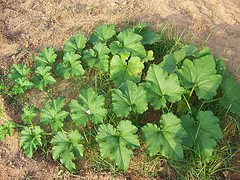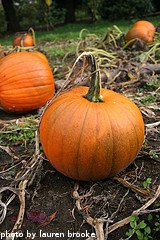Pumpkin Plant Diseases and Pest Problems

Garden pest problems often lead to pumpkin plant diseases. In general, pumpkins are strong plants and are able to resist many of these diseases. However, they are unable to defend themselves against harmful insects.
There are three main pests that can wreak havoc in your pumpkin patch:
- Cucumber Beetles
- Vine Borers
- Snails and Slugs
The most common enemy in your pumpkin patch is cucumber beetles. The striped cucumber beetle has black and yellow spots on its back. The spotted cucumber beetle has a yellow back with black spots. Both of these insects can damage the leaves and spread pumpkin plant diseases. Fortunately, cucumber beetles can be controlled with common insecticides including sprays and dust. Diazinon and Malathion are common chemicals that will kill cucumber beetles. Apply products that contain these pesticides according to the manufacturer's instructions. Most can be applied soon after the seedlings emerge and throughout the growing season. Organic insecticide products are also available.

Vine borers are a common garden pest and can do some serious damage. They will attack any summer or winter squash plant, along with cucumbers and pumpkins. They will bore into the vines at the base of your plant, sucking out the juices and eating the vines themselves. Once inside the vine, they will continue eating away at your plants from the inside out. Many times this damage is not noticed until significant and irreversible damage has already been done. The fruit growth will suddenly slow and the vine will wilt, shrivel and die. Many backyard vegetable gardeners see the plant wilting and assume that the problem is lack of water. If the plants continue to wilt after a thorough soaking, you're definitely battling vine borers. There are several products on the market that will prevent vine borer infestation. It's important to apply these products before your plants become affected. Read the labels on products that contain Diazinon or Carbaryl to make sure that the spray is effective against squash vine borers. Follow the manufacturers directions. Most of these insecticides can be applied soon after the seedlings first emerge.
Snails and slugs can cause problems for larger pumpkin varieties. They generally do not attack small and medium sized pumpkins. If you are growing giant pumpkins, beware of snails and slugs when the fruit first appears and before the skin becomes hard. They love to suck on the soft fruit of developing pumpkins. Special snail and slug pellets are available at most garden centers and can be spread around the plants. Some organic pumpkin growers put down a layer of sand under and around the developing fruit. For some reason, slugs and snails do not like to crawl across sand. If they can't reach the developing pumpkins, no damage will be done. Once the skin on the pumpkins begin to harden, snails and slugs will no longer attack the fruit.
We've had good results by implementing a preventative spray program for pests in our own garden using a homemade soap spray. We mix together 2 gallons water, 2 tablespoons liquid dish soap and 2 tablespoons hot sauce in a 2 gallon pressure prayer. We shake well to mix and spray all over our pumpkin plants every 10 days or so, or after every heavy rainfall. This mixture doesn't actually kill any pests, but it does encourage them to move elsewhere.
If you are sure you don't have pest problems in your garden, you are probably dealing with a bacterial or fungal infection. Some diseases that affect pumpkin plants are wilt disease, powdery mildew, downy mildew and scab disease. These are usually identified by a powder like substance on the leaves or stems. There may also be visible black spots or splotches on the leaves themselves. Most pumpkin plant diseases can be avoided by choosing disease resistance varieties and by keeping the garden clean and free of weeks. They can also be controlled with fungicides or organic soap sprays that are usually available at most garden centers.
We've implemented a preventative spray program in our own garden using a homemade fungicide. We mix together 2 gallons of water, 4 tablespoons hydrogen peroxide and 4 tablespoons baking soda. We mix it all up in a 2 gallon pressure sprayer and spray it all over our pumpkin plants to the point of runoff every 10 days or so, or after every heavy rainfall. This mixture works well at preventing fungal problems. However, if we get an infection, we switch to a commercial fungicide product.
Remember, many pest problems and pumpkin plant diseases are preventable. As the old saying goes, "An ounce of prevention is worth a pound of cure."

Click here to learn about fertilizing and watering pumpkin plants
Click here for information about harvesting pumpkins
Click here for some pumpkin recipe ideas
Click here to move from our Pumpkin Plant Diseases page to the Growing Pumpkins main page
Click here to return to our Home page
